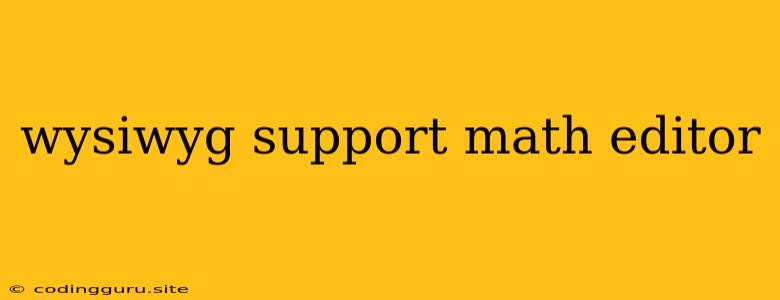WYSIWYG Support for Math Editors: A Seamless Equation Experience
In the world of technical writing, scientific research, and online education, the ability to easily create and display mathematical equations is crucial. WYSIWYG editors, known for their intuitive user interfaces, have become the go-to choice for many users. But how can we integrate the power of WYSIWYG support with the specific needs of math editors? Let's delve into this question and explore solutions that offer a seamless equation experience.
Why is WYSIWYG Support Essential for Math Editors?
WYSIWYG (What You See Is What You Get) editors provide a visual representation of the content being created. This eliminates the need to learn complex markup languages, making the editing process more accessible to a wider range of users. For math editors, the benefits are even more pronounced:
- Intuitive Equation Creation: WYSIWYG editors allow users to visually construct equations using familiar mathematical symbols and formatting options. No need to memorize complex LaTeX commands!
- Real-Time Preview: See the equation as you type, ensuring the desired visual representation is achieved. This eliminates the need for constant switching between editing and preview modes.
- Collaboration-Friendly: WYSIWYG editors simplify collaboration, enabling multiple users to work on the same document simultaneously.
Integrating WYSIWYG Support into Math Editors
Integrating WYSIWYG support into a math editor requires careful consideration of the following factors:
- Equation Rendering Engine: The chosen engine should be capable of accurately displaying a wide range of mathematical expressions, including complex formulas, symbols, and formatting options.
- User Interface Design: The user interface should be intuitive and easy to use, even for users unfamiliar with complex mathematical notation.
- Customization Options: Flexibility is key! Users should be able to customize the appearance of equations, including font size, color, and alignment.
Popular Solutions for WYSIWYG Math Editors
Several popular solutions have emerged to address the need for WYSIWYG support in math editors. Let's explore some of the leading options:
- MathJax: This JavaScript library is widely used for rendering mathematical equations on the web. It supports a rich set of LaTeX commands, offering a powerful yet flexible solution.
- KaTeX: A more lightweight alternative to MathJax, KaTeX provides fast rendering speeds and a focus on simplicity. It's often preferred for situations where performance is a priority.
- CKEditor Math: A plugin for the popular CKEditor WYSIWYG editor, this extension provides an easy-to-use interface for creating and editing mathematical equations.
- TinyMCE Math: Similar to CKEditor Math, TinyMCE Math provides a dedicated plugin for the TinyMCE editor, extending its functionality to include WYSIWYG math support.
Tips for Implementing WYSIWYG Support in Your Math Editor
- Choose the Right Rendering Engine: Evaluate the options discussed above based on your specific needs (performance, features, and integration).
- Design a User-Friendly Interface: Prioritize an intuitive interface that minimizes the learning curve for users. Consider incorporating visual cues and tooltips to guide users.
- Provide Robust Customization Options: Allow users to adjust equation appearance, font, and layout to match their preferences and document style.
Conclusion
WYSIWYG support for math editors is an essential component for creating a seamless and intuitive user experience. By leveraging the power of WYSIWYG editors, users can focus on the content itself, freeing them from the complexities of markup languages. The solutions explored in this article provide a solid starting point for implementing WYSIWYG support in your own projects, fostering a more accessible and efficient approach to mathematical expression.
